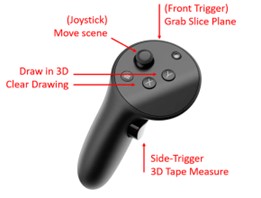VR developed by Albert Liu, Sayed Ahmad Almohri, Rebecca Lindsey, Ankit Mathanker, Bryan Goldsmith, Ahmet Emre, Nicholas Kotov and Theodore Hall
In this lab you will work in teams of 2 or 3 to study different types of nanoparticles in Virtual Reality. The lab will involve a series of questions to navigate these nanoparticles at the atomic scale, where one student will navigate the 3D molecular models and microscopy scans in VR, and the other students will take screenshots from the computer monitor to capture pictures of the ‘answers’ you provide. You can take turns in VR, and you should work as a team to interpret and navigate the microcosmos.
Once you get into the VR scene, the following are the controls. To move around the scene, you can walk around the room in real space. If the nanoparticle structure is not where you want it, you can use the joysticks on the controllers to move around the scene. Use the left-hand joystick to slide yourself forward-backward, left-right, or up-down. The position and orientation of the controller is tracked in 3D; point in the 3D direction you want to slide. Use the right-hand joystick to rotate yourself left-right. By using the two joysticks together, you can “orbit” by rotating right while sliding left, or vice versa. You can multiply your “flying” speed by a factor of 10 by holding the <Shift> key on the keyboard with your right hand (or your partner’s hand) while using the left-hand joystick.
To paint on the scene in 3D, you can use the X and Y (left-hand) or A and B (right-hand) buttons. Press and hold Y or B to paint in 3D, and press X or A to clear the paint. You will use this feature to annotate the 3D scene in your lab write-up. The two controllers are symmetric. Press and hold the side trigger with your middle finger (either hand) and “drag” to use the virtual 3D Tape Measure. The feedback displays dX, dY, dZ, dL: the first three numbers are the changes in the X, Y, and Z coordinates; the last number is the length or distance measured.



